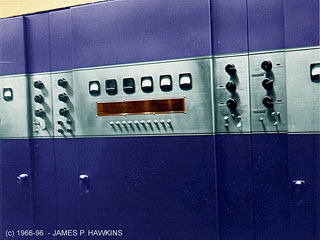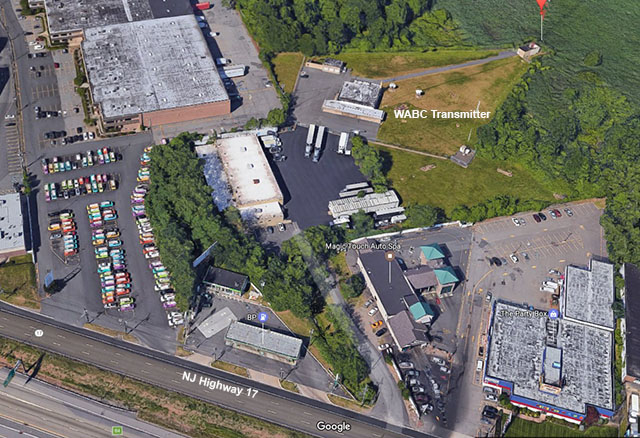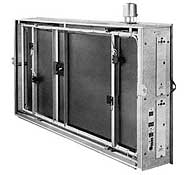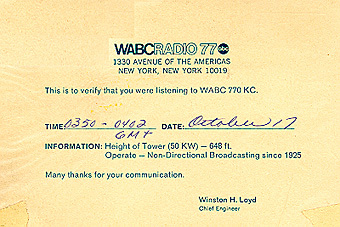 |
 |
|
These photos were taken at the WABC transmitter site in Lodi, NJ on August 12, 1966 when WABC was called
"Music Radio WABC". The late, Wayne Ely - W8LBB, was the transmitter engineer at the time. Wayne Ely had passed away at 63 recently at his Ohio home while chopping wood. He was a fun guy and a great engineer. He lived in Fort Lee, NJ when these pictures were taken. I hadn't seen Wayne for many years, but in his memory, I am thankful to him for his hospitality, friendship and his fun filled, youthful nature. I had visited him at his home a few times in the 60s where he made my friends and me feel welcome. I also thank him for the opportunity to take the photographs which made this page possible! He will be missed by his friends and family. Other contributions are annotated where appropriate and all contributors to the radio page are listed in the contributors list on the main page. The background was created from a photograph of an Eimac 304-TL tube, the type of which was used in one of the amplification stages of the WABC transmitter. I remember peering into the small window port of the 50KW transmitter, seeing them glow red hot! The tube I photographed was purchased recently at a ham fest, then I did some Adobe Photoshop magic on the image to give it the "hot" effect. Jim Hawkins - WA2WHV. |
| WABC billboard as seen at the entrance from NJ Rt. 17 south. |
|
| WABC Transmitter building as seen from NJ Rt. 17 south. As of today, May 23, 2017, the building is no longer visible from NJ 17. The grassy area is now completely occupied by industrial buildings right up to and within a few hundred feet ot the WABC building. |
 |
| As of today, 5/23/17, the WABC transmitter building is obstructed by numerous structures, making it invisible from the old viewpoint from NJ Route 17. |
IT ALL BEGINS WITH A
QUARTZ (SiO2) CRYSTAL!
|
|
This is a naturally formed specimen of Quartz crystal from my own collection. The specimen is from Arkansas, USA This mineral, when sliced properly, is like an electric pendulum, which keeps the time in our watches and clocks; generates the clock cycles in our computers, which step through instructions in the microprocessor; and generates the radio frequency waves that carry radio messages, to mention a few. Quartz is also used for its intrinsic beauty in jewelry. |
|---|
| The photographs below are of the crystals used to generate the radio frequency signal for 77 WABC. They are
out of the collection of Larry Mussman - K2MRG who was the transmitter chief engineer
after Wayne Ely left for Ohio. Larry kindly contributed these pictures. These are photos of the actual crystal units which made it possible for you to hear the sounds of Musicradio 77! |
| These are not tubes. They are containers of slices of quartz crystals which have a resonant frequency of 770,000
cycles per second. A crystal is a mineral that grows naturally in cavities of rock and is mined and used for many
purposes. Crystals have a characteristic known as the piezoelectric effect. When a steady electrical voltage (force)
is applied to electrodes holding the crystal, it contracts. When the polarity of the voltage is reversed, the crystal
expands. When this configuration is placed in an amplifier in the appropriate manner, the crystal will expand and
contract at a steady frequency and cause the voltage applied to it to vary at the same rate. This circuit is called
an oscillator, which is the source of the radio frequency signal. It is then amplified numerous times by the transmitter
which feeds the signal to the antenna or tower. So, the sound of Cousin Brucy, Dan Ingram, Herb Oscar Anderson,
Charlie Greer, Harry Harrison, the Beetles, Elvis and all the others were carried by a signal generated by this
tiny "glasslike" mineral vibrating at 770,000 times per second, putting the station at 77 on your radio
dial. In the upper, glass package, you can see the actual crystal suspended at the center of the container. The
frequency of these crystals were kept more steady by running them in ovens with very closely controlled temperatures
during operation. The (glass) crystal assembly was used for the Continental 10KW standby transmitter. The lower unit was used for the main GE 50KW transmitter. |
|
| Oscillators could run with tuned circuits consisting of a coil (inductance) and capacitor. A crystal takes the place of these components to create a very pure, stable radio frequency signal which does not drift all over the dial and creates a purer sinewave which is free of harmonics. The Federal Communications Commission requires that broadcast stations be run at very accurate, steady frequencies, hence, crystals are used. |
| GE 50KW Model BT-50-A HI LEVEL MODULATION TRANSMITTER. The high voltage supply to both the modulator and final amplifier is 9000 Volts. At 100% modulation, each modulator tube draws about 3.5 amperes. The final amplifier draws about 8 Amperes (4 amperes per tube). That's 72KW input power for 50KW output or 70% efficiency. I've been told that the electric bill is about $5,500.00/month for this model in one station using it today as compared approx. $1,800.00/month to run the new HARRIS DX-50. This would vary somewhat, depending on the location, of course. |
|
Wide view of transmitter room with 50KW XMTR on Right, Power Control panels on left and far end and console in foreground. |
Another view of the GE 50KW transmitter. |
10KW Continental Model 316B Emergency Transmitter |
|---|
|
WABC Main 50KW GE Transmitter |
View of Transmitter from behind main console. |
10KW Continental Emergency Transmitter |
|---|
| Four 304-TL, Low mu, power triode tubes operate in push-pull/parallel in a cathode follower configuration to drive the modulator tubes. They have a beauty of their own with a unique 4-barrel anode which glows red under normal maximum operating conditions. | |
| The final output tubes, a pair of 6427s could be seen glowing through a small window in the back of the transmitter.
The modulator also used a pair of these tubes. They appeared to be about 12" or more in diameter. This one
was given to me by Watt Hairston CE of WSM. It came out of the same model transmitter. It is about 16" tall. |
|
Main Power Panel |
Audio Patch, Chart Recording, Crystal Exciter/oven and other Equipment |
"Modulation Cage", located in back of the 50KW Transmitter. Contains modulations chokes and Modulation transformer (abt 3' high) at the far end. |
|---|
|
Power panels on wall opposite transmitter. |
Room behind transmitter cabinets showing the aisle between the 50KW transmitter and the modulation transformer cage. |
|---|
THE BIG SOUND! HOW WAS IT DONE?Remember the unmistakable reverberation on the sound of WABC? Well, at the time of these photos it was mechanically
done with a large metal plate suspended by springs! Jonathan Wolfert, President of JAM
Creative Productions, identified it as an "EMT 140 plate
reverb unit". |
 |
|
Newer Dynamoter for emergency power |
|---|
|
HUGE 6 Cylinder gas engine (just prior to removal) |
150KW Generator Driven by the aforementioned 6 "banger" |
Old modulation transformer and chokes ready to be "recycled". |
|---|
EMERGENCY!
|
SEVENTY SEVEN DOUBLE-U AYYYY BEEE CEEE
|
Changes at the WABC transmitter siteFrom what I have heard from some feedback I have received, some major changes occurred at WABC in the early
70's. The 10KW Continental Electronics auxiliary xmtr was
removed, the GE Hi-Level 50KW unit became an alternate-main, and a new Gates 50KW main xmtr was installed. It was
the first generation of transmitters using the pulse duration modulation concept (PDM) and allowed positive peak
modulation approaching 120%. It gave WABC more audio punch and "beat the pants off the old GE" as well
as every other 50KW in the area at the time. It is speculated that WABC got the third Gates PDM produced. KDKA
got the first, WGN the second. The 50KW GE was packed up and shipped off to some 3rd world country not long after
that and a second Gates (then Harris) 50KW with fully digital modulation was installed. WABC now uses the successor
to these units, the Harris DX-50 which uses digital pulse modulation. WINS, uses one, also. |
|
|
My thanks to the Late Wayne Ely for the tour. Thanks for additional technical information and support goes to Steve A. Uckerman, N2JXL, Asst. Chief Engineer WABC Radio, NY, Johnny Donovan of WABC NY and to Robert A. Dillehay of Electronic Communications who is an engineer at WOBS 1530KHZ, which still uses the GE 50KW transmitter. Thanks to Larry Mussman for supplying the photos of the original crystals. |
 |
| I wish I had been the recipient of this QSL, but it was kindly supplied by Bob Kozlarek WA2SQQ. |
|
| Accessed | times since January 1, 1997. |